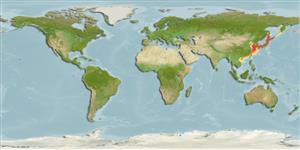>
Perciformes/Zoarcoidei (Eelpouts and pricklebacks) >
Stichaeidae (Pricklebacks) > Stichaeinae
Etymology: Ernogrammus: Greek, ernos, -eos, -ous = bud, shoot, descendenat + Greek, gramma = letter, mark, signal (Ref. 45335).
More on author: Schlegel.
Environment: milieu / climate zone / depth range / distribution range
экология
морской демерсальный; пределы глубины 0 - 142 m (Ref. 50610). Temperate
Northwest Pacific: Japan to the Gulf of Po-Hai (Gulf of Chihli), the Sea of Japan, and the southern Kuril Islands.
Size / Вес / Возраст
Maturity: Lm ? range ? - ? cm
Max length : 15.0 cm SL самец/пол неопределен; (Ref. 559)
Inhabit coastal, near rocky reefs among algae and rocks; also brackish waters (Ref. 51666). This nocturnal fish hide between stones during the day and move to sandy areas in the evening for foraging. Feeds mainly on polychaetes and mysids, decapod crustaceans, fishes, algae and sipunculans. A solitary species with low level of contacts and aggression. Potential predators include Squalus acanthias, Sebastes taczanowskii, and S. trivittatus, sea scorpions Myoxocephalus, and cormorants (Ref. 86742). Oviparous, eggs are guarded by the male (Ref. 58332).
Life cycle and mating behavior
половая зрелость | размножение | нерест | икра | Fecundity | личинки
Masuda, H., K. Amaoka, C. Araga, T. Uyeno and T. Yoshino, 1984. The fishes of the Japanese Archipelago. Vol. 1. Tokai University Press, Tokyo, Japan. 437 p. (text). (Ref. 559)
Статус Красного Списка МСОП (Ref. 130435: Version 2024-1)
Угроза для людей
Harmless
Использование человеком
дополнительная информация
инструменты
Специальные отчеты
Скачать в формате XML
ресурсы в Интернет
Estimates based on models
Preferred temperature (Ref.
123201): 3.8 - 20.6, mean 15.4 °C (based on 196 cells).
Phylogenetic diversity index (Ref.
82804): PD
50 = 0.6250 [Uniqueness, from 0.5 = low to 2.0 = high].
Bayesian length-weight: a=0.00447 (0.00232 - 0.00859), b=3.12 (2.95 - 3.29), in cm total length, based on LWR estimates for this species & (Sub)family-body (Ref.
93245).
Trophic level (Ref.
69278): 3.3 ±0.5 se; based on size and trophs of closest relatives
устойчивость к внешним воздействиям (Ref.
120179): средний (среднего размера), минимальное время удвоения популяции 1.4-4.4 года (Preliminary K or Fecundity.).
Fishing Vulnerability (Ref.
59153): Low vulnerability (10 of 100).
